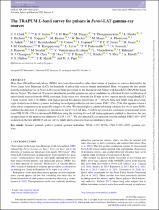| dc.identifier.citation | Clark, C.J., Breton, R.P., Barr, E.D., Burgay, M., Thongmeearkom, T., Nieder, L., Buchner, S., Stappers, B., Kramer, M., Becker, W. and Mayer, M., 2023. The TRAPUM L-band survey for pulsars in Fermi-LAT gamma-ray sources. Monthly Notices of the Royal Astronomical Society, 519(4), pp.5590-5606. | en_US |
| dc.description.abstract | More than 100 millisecond pulsars (MSPs) have been discovered in radio observations of gamma-ray sources detected by the Fermi Large Area Telescope (LAT), but hundreds of pulsar-like sources remain unidentified. Here, we present the first results from the targeted survey of Fermi-LAT sources being performed by the Transients and Pulsars with MeerKAT (TRAPUM) Large Survey Project. We observed 79 sources identified as possible gamma-ray pulsar candidates by a Random Forest classification of unassociated sources from the 4FGL catalogue. Each source was observed for 10 min on two separate epochs using MeerKAT’s L-band receiver (856–1712 MHz), with typical pulsed flux density sensitivities of Jy. Nine new MSPs were discovered, eight of which are in binary systems, including two eclipsing redbacks and one system, PSR J1526−2744, that appears to have a white dwarf companion in an unusually compact 5 h orbit. We obtained phase-connected timing solutions for two of these MSPs, enabling the detection of gamma-ray pulsations in the Fermi-LAT data. A follow-up search for continuous gravitational waves from PSR J1526−2744 in Advanced LIGO data using the resulting Fermi-LAT timing ephemeris yielded no detection, but sets an upper limit on the neutron star ellipticity of 2.45 × 10−8. We also detected X-ray emission from the redback PSR J1803−6707 in data from the first eROSITA all-sky survey, likely due to emission from an intrabinary shock. | en_US |

